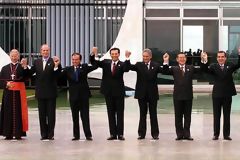Peru has undergone many upheavals during its republican history, marked by internal conflicts, wars with its neighbors, and periods of political instability. One of the most important stages of its modern history is the War of the Pacific (1879-1883), which pitted Peru and Bolivia against Chile.
 In 1879, the War of the Pacific broke out due to growing tensions over the exploitation of nitrate mines in the Atacama Desert, a region rich in natural resources but contested among the three countries. Chile, better prepared militarily, dealt a humiliating defeat to Peru and Bolivia. In 1883, the Treaty of Ancón formalized Peru’s loss of the Tarapacá region and Chile’s control over the nitrate mines, which severely impacted the Peruvian economy.
In 1879, the War of the Pacific broke out due to growing tensions over the exploitation of nitrate mines in the Atacama Desert, a region rich in natural resources but contested among the three countries. Chile, better prepared militarily, dealt a humiliating defeat to Peru and Bolivia. In 1883, the Treaty of Ancón formalized Peru’s loss of the Tarapacá region and Chile’s control over the nitrate mines, which severely impacted the Peruvian economy.
After the War of the Pacific, Peru was engaged in other border conflicts. In 1941, a territorial dispute erupted with Ecuador, leading to war. The Rio de Janeiro Treaty, signed in 1942, granted Peru control over the northern part of the Marañón River. However, this decision was hotly contested by Ecuador, and border tensions continued to plague relations between the two countries for several decades.
The 1960s saw the emergence of revolutionary movements in Peru, inspired by the Cuban Revolution. In 1965, the National Liberation Army, a guerrilla group influenced by communist ideology, attempted to seize power by force. Their attempt failed, but it marked the beginning of a period of political instability.
 In the 1980s, the situation worsened with the rise of new guerrilla movements. The Shining Path (Sendero Luminoso), a Maoist group, led a violent campaign of terrorism and sabotage against the state. The Tupac Amaru Revolutionary Movement (MRTA) also contributed to this wave of violence. These groups sowed terror, particularly in rural areas, and the government's repression was brutal, exacerbating social tensions.
In the 1980s, the situation worsened with the rise of new guerrilla movements. The Shining Path (Sendero Luminoso), a Maoist group, led a violent campaign of terrorism and sabotage against the state. The Tupac Amaru Revolutionary Movement (MRTA) also contributed to this wave of violence. These groups sowed terror, particularly in rural areas, and the government's repression was brutal, exacerbating social tensions.
In 1990, Alberto Fujimori Fujimori, an engineer of Japanese descent, won the presidential elections against Mario Vargas Llosa. His mandate was marked by a policy of economic austerity and an intense fight against terrorist groups. In 1992, the capture of the Shining Path leader, Abimael Guzmán, was a turning point in the fight against the guerrillas, although violence had not entirely disappeared.
In 1995, another conflict broke out with Ecuador over the border, requiring international mediation to avoid a large-scale war. Despite Fujimori’s diplomatic victory, the main social problem remained poverty and unemployment, which affected much of the Peruvian population.
In April 1995, Fujimori was re-elected with a majority of 64.42% of the vote, defeating Javier Pérez de Cuéllar, former Secretary-General of the United Nations. Despite his popularity for restoring some stability, his government increasingly faced criticism for its authoritarian drift and human rights violations. Corruption also became a growing concern.
In 2000, the Peruvian political situation worsened when corruption scandals involving Fujimori and his trusted advisor Vladimiro Montesinos came to light. Popular and international pressure forced Fujimori to flee to Japan, from where he resigned. His departure opened a difficult period of political transition, marked by efforts to restore democratic reforms.
Since Fujimori’s downfall, Peru has experienced a period of relative political stability, although significant economic and social challenges remain. Economic growth, mainly driven by the export of natural resources such as copper and zinc, has helped gradually reduce poverty. However, social inequality and the marginalization of indigenous and rural populations remain sources of tension.
Successive governments have had to balance the management of natural resources with environmental protection, as mining projects in the Andean regions have often led to conflicts between local communities and the state.
Corruption remains a major problem in Peru, as evidenced by the imprisonment of several former presidents for bribery and embezzlement. Despite this, the country continues to strive to strengthen its democratic institutions and attract foreign investment while fighting poverty and inequality.
Today’s Peru is a country in transition, facing the challenges of modernization while being rooted in its cultural and historical heritage. The political instability of the late 20th century has given way to an era of reforms, but economic and social tensions remain. Nevertheless, Peru continues to move forward with determination towards a more prosperous future, while seeking to preserve its rich historical and cultural heritage.